
Concept explainers
A standing wave is described by the wave function
where x and y are in meters and t is in seconds. (a) Prepare graphs showing y as a function of x for five instants: t = 0, 5 ms, 10 ms, 15 ms, and 20 ms. (b) From the graph, identify the wavelength of the wave and explain how to do so. (c) From the graph, identify the frequency of the wave and explain how to do so. (d) From the equation, directly identify the wavelength of the wave and explain bow to do so. (e) From the equation, directly identify the frequency and explain how to do so.
(a)
To draw: The graphs showing
Answer to Problem 18.18P
The graph of
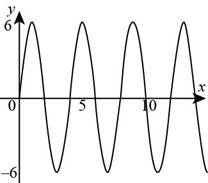
Figure (1)
The graph of

Figure (2)
The graph of
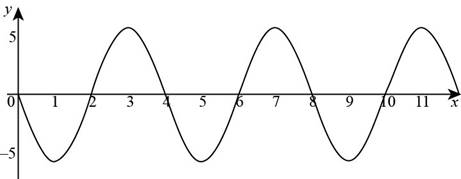
Figure (3)
The graph of

Figure (4)
The graph of

Figure (5)
Explanation of Solution
Introduction:
The values of
Explanation:
Given info: The sinusoidal waves function is,
For
Substitute
The graph of
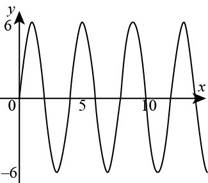
Figure (1)
For
Substitute
The graph of

Figure (2)
For
Substitute
The graph of
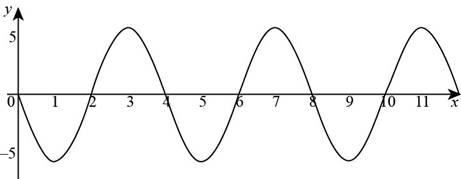
Figure (3)
For
Substitute
The graph of

Figure (4)
For
Substitute
The graph of
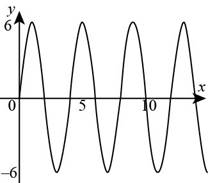
Figure (5)
(b)
Answer to Problem 18.18P
Explanation of Solution
Given info: The sinusoidal waves function is
The distance between the two-crest point or two trough point is called the wavelength of the wave.
From the figure (1), the distance between the two crest point is
Conclusion:
Therefore, the wavelength of the wave is
(c)
Answer to Problem 18.18P
Explanation of Solution
Given info: The sinusoidal waves function is
Compare the equation (1) with
The frequency of the wave is,
Substitute
Conclusion:
Therefore, the frequency of the wave is
(d)
Answer to Problem 18.18P
Explanation of Solution
Given info: The sinusoidal waves function is
Compare the equation (1) with
The frequency of the wave is,
Substitute
Conclusion:
Therefore, the wavelength of the wave is
(e)
Answer to Problem 18.18P
Explanation of Solution
Given info: The sinusoidal waves function is
Compare the equation (1) with
The frequency of the wave is,
Substitute
Conclusion:
Therefore, the frequency of the wave is
Want to see more full solutions like this?
Chapter 18 Solutions
Physics for Scientists and Engineers, Technology Update (No access codes included)
- The equation of a harmonic wave propagating along a stretched string is represented by y(x, t) = 4.0 sin (1.5x 45t), where x and y are in meters and the time t is in seconds. a. In what direction is the wave propagating? be. N What are the b. amplitude, c. wavelength, d. frequency, and e. propagation speed of the wave?arrow_forwardTwo traveling sinusoidal waves are described by the wave functions y1 = 5.00 sin [(4.00x 1 200t)] y2 = 5.00 sin [(4.00x 1 200t 0.250)] where x, y1 and y2 are in meters and t is in seconds. (a) What is the amplitude of the resultant wave function y1 + y2? (b) What is the frequency of the resultant wave function?arrow_forwardA sound wave can be characterized as (a) a transverse wave, (b) a longitudinal wave, (c) a transverse wave or a longitudinal wave, depending on the nature of its source, (d) one that carries no energy, or (e) a wave that does not require a medium to be transmitted from one place to the other.arrow_forward
- Rank the waves represented by the following functions from the largest to the smallest according to (i) their amplitudes, (ii) their wavelengths, (iii) their frequencies, (iv) their periods, and (v) their speeds. If the values of a quantity are equal for two waves, show them as having equal rank. For all functions, x and y are in meters and t is in seconds. (a) y = 4 sin (3x 15t) (b) y = 6 cos (3x + 15t 2) (c) y = 8 sin (2x + 15t) (d) y = 8 cos (4x + 20t) (e) y = 7 sin (6x + 24t)arrow_forwardAt t = 0, a transverse pulse in a wire is described by the function y=6.00x2+3.00 where xand y are in meters. If the pulse is traveling in the positive x direction with a speed of 4.50 m/s, write the function y(x, t) that describes this pulse.arrow_forwardA taut rope has a mass of 0.180 kg and a length of 3.60 m. What power must be supplied to the rope so as to generate sinusoidal waves having an amplitude of 0.100 m and a wavelength of 0.500 m and traveling with a speed of 30.0 m/s?arrow_forward
- A transverse wave on a string is described by the wave function y=0.120sin(8x+4t) where x and y are in meters and t is in seconds. Determine (a) the transverse speed and (b) the transverse acceleration at t = 0.200 s for an element of the string located at x = 1.60 m. What are (c) the wavelength, (d) the period, and (e) the speed of propagation of this wave?arrow_forwardTwo sinusoidal waves are moving through a medium in the same direction, both having amplitudes of 3.00 cm, a wavelength of 5.20 m, and a period of 6.52 s, but one has a phase shift of an angle . What is the phase shift if the resultant wave has an amplitude of 5.00 cm? [Hint: Use the trig identity sinu+sinv=2sin(u+v2)cos(uv2)arrow_forwardA sound wave in air has a pressure amplitude equal to 4.00 103 Pa. Calculate the displacement amplitude of the wave at a frequency of 10.0 kHz.arrow_forward
- A harmonic transverse wave function is given by y(x, t) = (0.850 m) sin (15.3x + 10.4t) where all values are in the appropriate SI units. a. What are the propagation speed and direction of the waves travel? b. What are the waves period and wavelength? c. What is the amplitude? d. If the amplitude is doubled, what happens to the speed of the wave?arrow_forwardA steel wire of length 30.0 m and a copper wire of length 20.0 m, both with 1.00-mm diameters, are connected end to end and stretched to a tension of 150 N. During what time interval will a transverse wave travel the entire length of the two wires?arrow_forward
 Principles of Physics: A Calculus-Based TextPhysicsISBN:9781133104261Author:Raymond A. Serway, John W. JewettPublisher:Cengage Learning
Principles of Physics: A Calculus-Based TextPhysicsISBN:9781133104261Author:Raymond A. Serway, John W. JewettPublisher:Cengage Learning Physics for Scientists and Engineers: Foundations...PhysicsISBN:9781133939146Author:Katz, Debora M.Publisher:Cengage Learning
Physics for Scientists and Engineers: Foundations...PhysicsISBN:9781133939146Author:Katz, Debora M.Publisher:Cengage Learning Physics for Scientists and Engineers, Technology ...PhysicsISBN:9781305116399Author:Raymond A. Serway, John W. JewettPublisher:Cengage Learning
Physics for Scientists and Engineers, Technology ...PhysicsISBN:9781305116399Author:Raymond A. Serway, John W. JewettPublisher:Cengage Learning University Physics Volume 1PhysicsISBN:9781938168277Author:William Moebs, Samuel J. Ling, Jeff SannyPublisher:OpenStax - Rice University
University Physics Volume 1PhysicsISBN:9781938168277Author:William Moebs, Samuel J. Ling, Jeff SannyPublisher:OpenStax - Rice University



